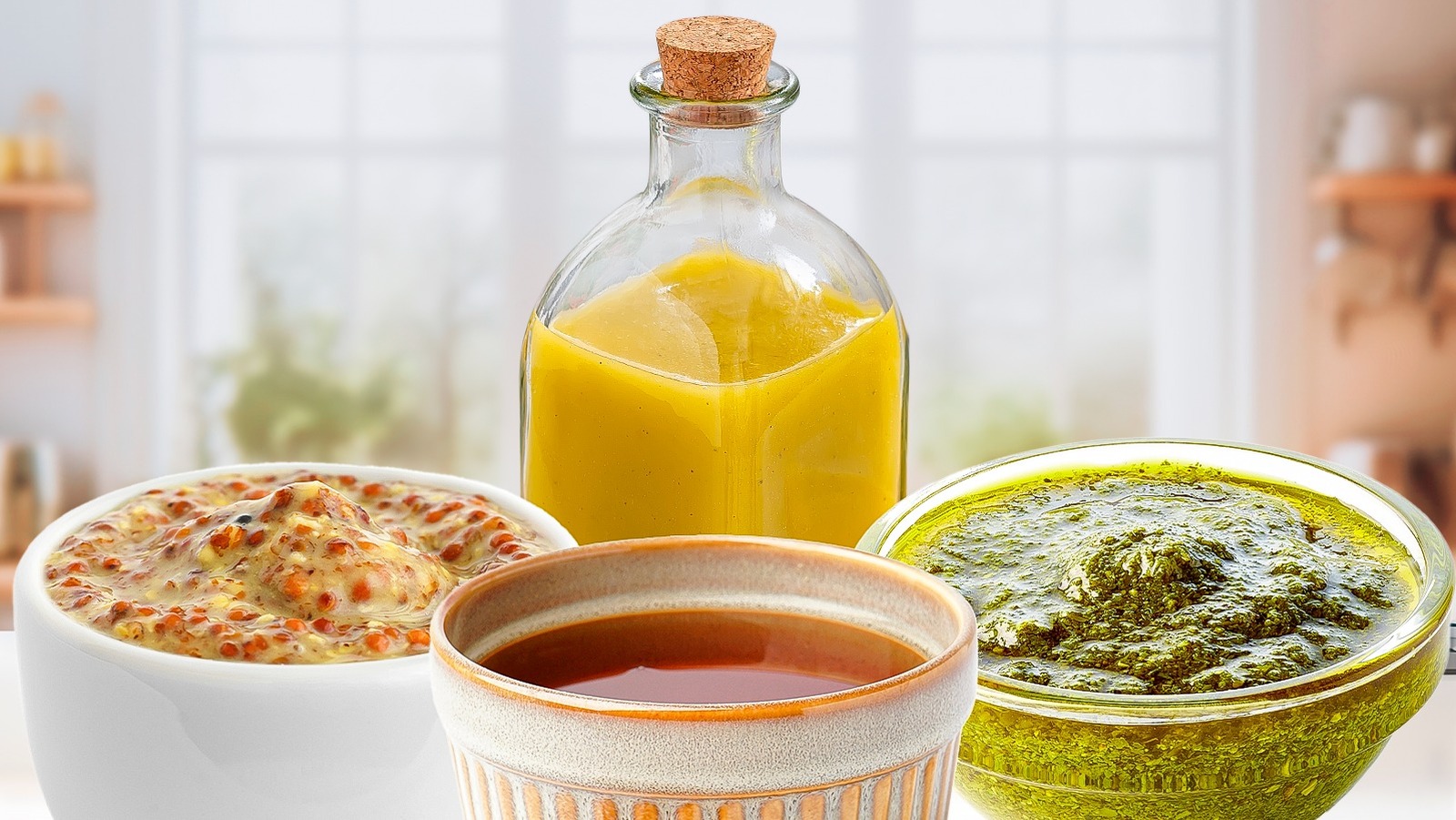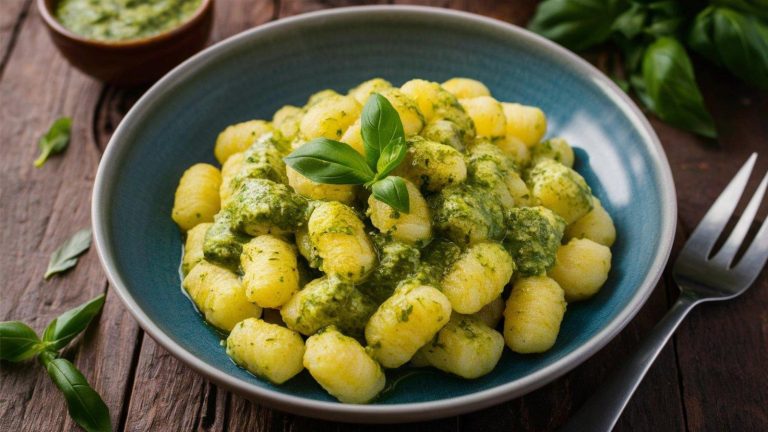No salad is complete without a flavorful dressing, but you don’t always have to go down the rich and creamy route. Adding a vinaigrette to your vibrant bowl is the perfect way to keep things light and fresh, whilst ensuring every element of the salad gets coated in delightful tangy flavor.
In its basic form, a vinaigrette is a type of dressing that combines oil and vinegar, usually in a ratio of around three to one. The exact varieties you use are down to you, but olive oil, canola oil, balsamic vinegar, and apple cider vinegar are popular choices. With these two ingredients as a base, the dressing can then be customized with additional ingredients, perhaps to add sweetness, sharpness, or aromatic flavor. And, there is a wider range of options to consider than you might think.
If you’ve been whipping up the same old dressings for your homemade salads, it might be time to switch things up and explore some new combinations. With the right add-ins, you can take a basic vinaigrette to new levels of deliciousness and completely transform the overall flavor of your meal. So, let’s take a look at some of the very best ingredients for jazzing up your next tangy mix-up.
Dijon mustard
Dijon mustard is a classic addition to a vinaigrette, and for good reason. A simple dollop can go a long way in enhancing both the flavor and texture of your dressing. When this smooth mustard is combined with the oil and vinegar, it acts as an emulsifier, helping to bind the two base elements together and prevent separation. It also adds a wonderful, sharp tang to the vinaigrette, which works with a wide range of common salad ingredients. You might also like to balance the flavor of the mustard with some sweetness, perhaps in the form of honey or maple syrup, for a well-rounded taste.
To make a mustard-infused vinaigrette, simply add the oil, vinegar, and mustard to a bowl and whisk well to combine. You could also shake the ingredients together in a jar if preferred. Then, drizzle the vinaigrette over your salad and toss well to coat everything. The bite of the mustard will taste great alongside fresh, leafy greens like diced romaine lettuce, baby spinach, or arugula, as well as juicy cherry tomatoes and sweet bell peppers. Protein-wise, chicken or tuna would make excellent choices.
Hot honey
There are so many ways to use hot honey, and including it in a vinaigrette has to be one of our favorites. Drizzle this irresistible, chili-infused honey into the oil and vinegar mixture to serve as a dynamic flavor booster, imparting plenty of sweetness and a subtle dose of heat. Feel free to pair this fiery add-in with some complementary ingredients, such as Dijon mustard, garlic, and perhaps even some finely minced shallots. The final vinaigrette would provide a fantastic contrast to a range of savory salad elements, such as pan-fried halloumi, grilled chicken breast, or salmon.
The most convenient option here is to pick up a store-bought hot honey, but making your own batch is a great way to customize the spice level to your taste. It’s remarkably easy, requiring just three ingredients. Add honey and red pepper flakes to a small saucepan and heat until simmering. Then, remove the pan from the heat and let it rest for around 10 minutes to let the flavors meld. Finally, you’ll need to strain out the red pepper flakes and stir in a splash of apple cider vinegar. Then, the hot honey is ready to add to your vinaigrette.
Maple syrup
We know that honey is a popular vinaigrette ingredient, but there’s another way to add sweetness to your dressing. Maple syrup can offer a slightly more robust, rich flavor, with notes of caramel and vanilla. It’s also a fantastic option if you need to keep your salad vegan-friendly, since honey is a no-go for many following a plant-based diet.
With its runny, pourable texture, maple syrup is incredibly easy to incorporate into the vinaigrette mixture. Start by stirring a tablespoon of syrup into your oil and vinegar base, then taste and adjust as you go. This sweet add-in would fit in seamlessly with a combination of apple cider vinegar, olive oil, and Dijon mustard, plus a good pinch of salt and black pepper.
A maple vinaigrette is ideal for fall-inspired salads — think roasted butternut squash, sliced apples, and toasted walnuts or pecans. It can also be nice to contrast the sweetness of the dressing with a salty, tangy cheese, such as crumbled feta or shaved parmesan.
Fresh herbs
To add some gorgeous flecks of green and a delicious dose of brightness to your salad, consider mixing fresh, chopped herbs into your vinaigrette. Whether you prefer the zesty hit of cilantro, the subtle peppery taste of parsley, or the earthiness of basil, there’s a herb to suit your taste preferences and the vibe of your salad. Dill, chives, oregano, and mint will work wonderfully too, and you could even incorporate a mixture of a few. Just make sure to chop the leaves finely to ensure even distribution and maximum flavor infusion.
Now that you’ve injected some herbaceous flavor into your vinaigrette, there’s always the option to enhance this further with a couple of extra add-ins. Our go-to pairings for fresh herbs are a squeeze of lemon juice and some minced garlic, but go ahead and customize your zesty creation as you see fit. Now, all that’s left to do is drizzle the herb-loaded vinaigrette over your salad of choice. How about a caprese-style number with juicy tomatoes and sliced mozzarella? Or, try tossing it through a wholesome quinoa salad with chickpeas, olives, and crunchy cucumber.
Minced shallots
Give your vinaigrette a mouth-watering, aromatic upgrade with the addition of minced shallot. This packs a punch in the flavor department, whilst also adding a little texture to the dressing. Shallot can be substituted for onion here, but the former will provide a more delicate and slightly sweeter taste that’s less likely to overpower the other elements of your dressing. And, the “minced” aspect of this add-in is crucial, as chunkier pieces won’t release flavor in quite the same way.
To mince a shallot, first slice it lengthwise into two pieces and peel off the papery outer layer. Place a half cut-side down, and make a series of vertical cuts along its length, as close together as you can, but keep the root end intact. Then, make horizontal cuts into the shallot, again finishing close to the root. Now, starting from the short, non-root end, slice vertically, all the way up to the root. Repeat for the other half, and you should now have a finely minced shallot.
Try combining the minced shallots with other aromatic or citrusy vinaigrette ingredients, such as garlic, lemon or orange juice, herbs, and mustard. This dressing is versatile enough to spruce up everything from a simple medley of leafy greens to a decadent meat, cheese, or fruit-packed salad.
Garlic
Another deeply aromatic and highly effective vinaigrette enhancer is garlic. There are few ingredients it doesn’t pair beautifully with, and it serves as an amazing base for building upon with other flavor notes. You can add garlic to your vinaigrette either in the form of fresh, minced garlic or opt for the convenience of garlic powder. Fresh garlic will impart a stronger taste, so start with a small amount and increase as desired. Another excellent option is roasted garlic, which will provide a sweeter, more mellow flavor. With this, the best method is to blitz the roasted and peeled cloves with the other vinaigrette ingredients in a blender or food processor.
Garlic will undoubtedly complement all of the classics, like mustard, honey, and herbs. But, if you’re after something a little more unique, you could whip up a spicy, Asian-inspired vinaigrette with soy sauce, lime juice, and red pepper flakes. You could even try blitzing fresh tomatoes into your garlicky vinaigrette for a vibrant, Italian-style twist. We love tossing garlic-infused dressings through a hearty three-bean salad, or a herby pasta salad with shredded chicken and avocado.
Ginger
There’s nothing quite like ginger for bringing a bold, invigorating warmth to a vinaigrette. It’s a particularly fitting add-in when you’re throwing sweet ingredients into the mix, like honey or orange juice, and works brilliantly in Asian-inspired dressings. Just grate or mince it finely before stirring it into the dressing. Or, for an ultra-smooth finish, blitz everything in a food processor.
When it comes to flavor pairings for ginger, lime deserves a notable mention. In fact, this punchy duo features in many a Tasting Table salad recipe, including our Mongolian beef salad and colorful toasted sesame noodle salad. Another great way to use ginger is alongside miso paste, maple syrup, and garlic, which come together to craft a vinaigrette with a wonderfully balanced, umami-rich depth. You could even blend chunks of ginger, carrot, and onion into a peanut oil and rice vinegar-based dressing, along with a splash of soy sauce, for a vibrant, savory finish.
Serve your fiery vinaigrette with a rainbow of crunchy veggies, such as sliced radishes, bell peppers, red cabbage, and kale. If you’re adding protein to the salad, such as tofu or chicken, you could also try coating this in a ginger-based marinade before cooking.
Smoked paprika
Looking to elevate your vinaigrette with a subtle, smoky heat? Smoked paprika is the perfect option. As well as introducing that signature warming taste, it’ll also tint your dressing with a gorgeous red-orange hue, making it a standout addition to any salad. To switch up the flavor profile slightly, you could also opt for sweet or hot paprika if preferred.
Smoked paprika will work great with a base of red wine vinegar and olive oil. To create a well-balanced vinaigrette, try mixing in some garlic, honey, and dried oregano too. Like ginger, paprika also pairs fantastically with lime, and you can combine it with other spices like cumin, chili powder, or cayenne pepper.
And, as for the final, nutritious bowlful, we love the idea of tossing this spicy vinaigrette in a taco salad. Start with a base of chopped romaine lettuce leaves, and mix through some drained and rinsed black beans and corn, cherry tomatoes, and diced avocado. Toss the salad with the dressing, then top with sauteed, seasoned ground beef and plenty of shredded cheddar cheese.
Pesto
For creating a gloriously green, herb-ified vinaigrette, bright and fresh pesto is your friend. This much-loved Italian sauce is rich, nutty, cheesy, and guaranteed to give anything it touches a serious flavor boost. The simplest technique is to grab a store-bought jar of pesto and mix it directly into the oil and vinegar — perhaps with a squeeze of lemon juice and a pinch of salt. But, blending up the individual pesto ingredients from scratch will yield a superior flavor.
Typically, homemade pesto already contains olive oil and has a thick, almost spreadable texture. To create a more vinaigrette-like taste and consistency, you’ll need to add vinegar (white wine or apple cider vinegar are good options). Add the vinegar to a food processor along with the usual pesto components — fresh basil, pine nuts, garlic, lemon juice, parmesan, and salt, and blitz everything together. Then, with the mixer running, slowly pour in the olive oil, blending until you have a smooth, slightly runny texture. You can always thin out the dressing with a splash of water or extra lemon juice if desired.
Bourbon
Bourbon might seem like an unlikely salad ingredient, but its boozy warmth works remarkably well as part of a dressing. You’ll only need a tablespoon or two of liquor to give a vinaigrette a subtle kick, but this can, of course, be adjusted to your taste if you like things on the stronger side. For a sweet and tangy vinaigrette with a twist, mix the bourbon with some apple cider vinegar, canola oil, maple syrup, Dijon mustard, and minced shallots. Or, build on the spicy notes of the drink with the addition of fresh, grated ginger, perhaps balanced with a splash of sweet orange juice.
This one will shine as part of a warm, winter salad. Ingredients like roasted Brussels sprouts, butternut squash, pomegranate seeds, and toasted pumpkin seeds would make especially delicious accompaniments to the bourbon. Or, for a more summery vibe, try drizzling the spiked vinaigrette over a colorful grilled peach, feta, and arugula salad.
Anchovies
When it comes to savory flavor, anchovies are king. They pack a potent umami depth, and often feature in pasta dishes like the classic Italian spaghetti puttanesca. It’s no surprise that these small but mighty fish can make a pretty mean vinaigrette. Just pick out a couple of filets from a can of anchovies, roughly chop, and then mash them with a fork until you have a paste-like consistency. This can then be whisked or shaken with the other vinaigrette ingredients, such as white wine vinegar, extra virgin olive oil, Dijon mustard, and minced garlic.
The dressing works with other savory or salty salad elements like eggs, tuna, or crumbled bacon, as it can contrast with sweeter ingredients such as fresh apples, orange slices, or pomegranate seeds. Briny additions will taste great with the anchovy-infused vinaigrette, too, with olives, capers, or diced pickles all being great choices.
Fresh berries
Fruit can have its place in a salad, but why not include it in the vinaigrette too? Fresh berries are a marvelous add-in for bringing color, natural sweetness, and tang to your dressing. Make a light and summery strawberry vinaigrette by blitzing the fresh or frozen berries in a food processor with your choice of oil and vinegar, plus a drizzle of honey and a pinch of salt. Or, go for a refreshing raspberry and mint blend, perhaps with a tangy balsamic vinegar base.
Blueberries and blackberries can also be substituted in, or even combined with other berries, and don’t be shy about pairing them with savory ingredients like garlic or mustard. After all, a balanced result is the aim. You’re not making a dessert sauce! You can continue the berry theme into the salad, too. A strawberry arugula salad is a delightfully refreshing option, and you could give the mustard and shallot vinaigrette a fruity upgrade. A berry dressing would be an excellent choice for a refreshing watermelon and feta salad, too.
Orange juice
Another fantastically fruity way to upgrade vinaigrette is with orange juice. This adds sweetness and tang, whilst leaving your dressing with an inviting sunny hue. And, it’s versatile too. To make a beautifully zesty and flavorful mixture, whisk orange juice with balsamic vinegar, olive oil, Dijon mustard, and honey. You could toss in some orange zest as well, for a punchier citrus hit. Orange juice can also be paired with warming spices like cumin, allspice, or red pepper flakes.
The refreshing zing of orange tastes phenomenal with a range of sweet and peppery vegetables like carrots, radishes, and beets, as well as creamy diced avocado. It’s also an ideal choice for brightening up seafood salads. Try adding pan-fried shrimp, cod, or salmon into the mix for a subtle, salty flavor contrast. Garnishing with charred citrus slices, whether that’s orange, mandarin, or grapefruit, can take the tang up a notch, all whilst adding an elegant finishing touch to your salad.
Parmesan cheese
Sometimes a simple vinaigrette needs a little extra richness, and that’s where parmesan cheese can come in. This sharp, nutty cheese adds heaps of savory goodness to the dressing, and it’s particularly fitting if you’re whipping up an Italian-inspired salad.
Along with the oil and vinegar base, we recommend pairing the parmesan with some garlic, Italian seasoning, and salt. A dash of honey is also great for rounding out these savory elements. And, if you like your dressing with a kick, toss in some red pepper flakes too. Simply add everything to a food processor or blender, and blitz until smooth.
To build a classic Italian chopped salad, go for a mixture of iceberg lettuce, radicchio, red onion, cherry tomatoes, and pepperoncini. Mozzarella and provolone are also popular additions. This dressing would also be brilliant in a classic Cobb salad, made with chicken, bacon, hard-boiled eggs, and avocados. Or, toss it through a basic pasta salad to amp up the indulgence factor.
Pomegranate seeds
These striking little seeds can often be found scattered atop a salad, but they shine as part of the dressing, too. Pomegranate seeds offer a refreshing, sweet-tart flavor and plenty of color, so your vinaigrette will taste as good as it looks. And, the seeds are certainly a healthy choice, being packed with fiber, antioxidants, and essential nutrients like vitamin C and folate.
First, choose your specific oil and vinegar duo. Add these to a blender or food processor with the pomegranate seeds and any other add-ins that take your fancy. We recommend a splash each of lemon juice and maple syrup, a pinch of salt, and a dollop of mustard. Once blitzed up, the mixture will be a pleasing shade of pink. To complement this dressing’s natural sweetness, pair it with sharp or tangy salad ingredients, like feta cheese, red onion, or arugula. Fresh herbs like dill, parsley, or mint work great with the pomegranate, too.





